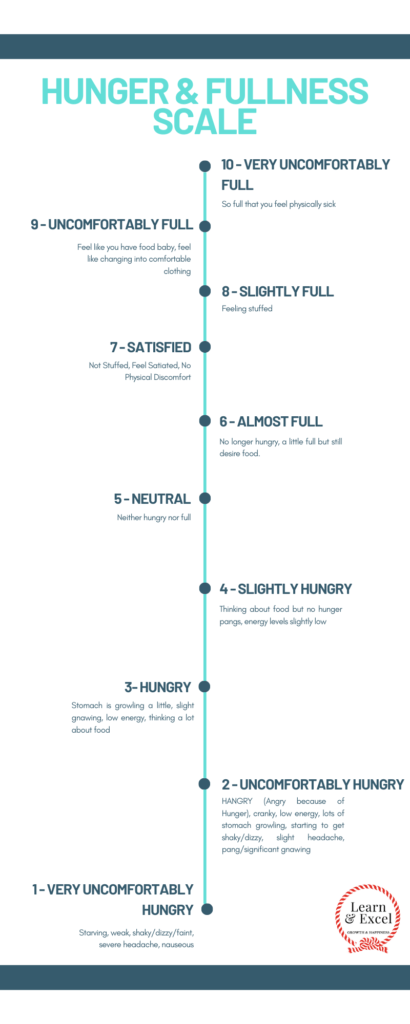Listen to Hunger as it is our body’s primal mechanism of letting us know that it needs to be nourished. We need to replenish the body with nutrients so that it is able to function properly.
One of the main reasons for obesity and being overweight stems from eating without Actual Hunger. Eating right and in tune with actual hunger aids in weight loss and weight management.
Projected Hunger & Hedonic Hunger
Once we start listening to our bodies and start identifying the Hunger Cues and learn to differentiate Actual Hunger from Projected Hunger and Hedonic Hunger we are likely to move towards being healthier.
Projected Hunger means that you are not physically hungry but you are still craving food. It can be due to any of the following reasons:
- Due to Thirst
- Habitual Eating
- Emotional Eating
Hedonic Hunger’ refers to one’s preoccupation with and desire to consume foods for the purposes of pleasure and in the absence of actual hunger. Examples of Hedonic Hunger are: If I see or smell food I like, I get a powerful urge to eat; It seems like I think about food a lot; and, I think I enjoy eating a lot.
Tips to Listen to Hunger
Here are a few tools and techniques to help you listen to Hunger and Fullness.
1. Investigate your Hunger and Listen to Hunger
Investing your hunger with Why? When? What? will help you in understanding your hunger better and in turn will help you make better choices.
Ask yourself these questions:
- Why am I eating now?
- Why am I eating what I am eating?
- Am I truly hungry?
- Do I feel lightheaded because I haven’t eaten for a while?
- Or am I eating because the clock says it’s time?
2. Use the Hunger and Fullness Scale to Listen to Hunger
When you start feeling like you want something to eat, rate your hunger on a scale of 1 to 10, with 1 being starving and 10 being so full you feel sick.

The goal here isn’t that you should be able to pinpoint the level you are at, you might feel like you are in between the two numbers and that is Okay! Listen to Hunger and then looking at the scale rule out the ones that aren’t fit for what you are feeling and you will get a number on the scale to rate your hunger or fullness.
It is best to eat when your Hunger is at a level of 3 or 4. At this stage, the blood sugar levels in the body aren’t too low so you are in a position to think rationally and make informed choices on the food you are picking to eat. This will help you in making wiser choices toward more nutritional options.
Don’t wait until your hunger gets down to 1 or 2. Getting too hungry can either lead to overeating or can make you sick with nausea. In addition to that at the 1-2 stage you are not thinking right and making informed choices so you are likely to eat whatever you get your hands on.
When you sit down to eat, stop and think about how hungry you are. Stop eating when you reach 5 -7 on the scale. It is always better to Err on the lower side than on the higher side so it would be best to stop at 5 or 6 so that you do not overeat at all.
3. 20 minutes Eat Habot to make it easy to Listen to Hunger
According to Harvard Health “Stretch receptors in the stomach are activated as it fills with food or water; these signal the brain directly through the vagus nerve that connects gut and brainstem. Hormonal signals are released as partially digested food enters the small intestine.
One example is cholecystokinin (CCK), released by the intestines in response to food consumed during a meal.
Another hormone, leptin, produced by fat cells, is an adiposity signal that communicates with the brain about long-range needs and satiety, based on the body’s energy stores. Research suggests that leptin amplifies the CCK signals, to enhance the feeling of fullness.
Other research suggests that leptin also interacts with the neurotransmitter dopamine in the brain to produce a feeling of pleasure after eating. The theory is that, by eating too quickly, people may not give this intricate hormonal cross-talk system enough time to work.”
Hence it is advisable to stretch your meal to 20+ minutes, giving enough time for the brain to receive the signal of fullness. This will prevent you from overeating and make you feel fuller and satiated.
4. Learn from Jordan Coffee Culture to Listen to Hunger
According to Jordan’s coffee culture, the guest when offered coffee has to take the first cup, or else he would be considered rude. If he needs a refill he shakes his cup from side to side but he is expected to take the 3rd cup as well if he goes in for the 2nd cup. He can’t stop at the 2nd cup.
So, before asking for a refill the second time, one has to be sure that he can take the third cup as well. Thus, you can take an odd number of helpings (1,3,5,7..) and not stop at an even number of helpings (2,4,6…). The good thing is that they fill the cup only to a few centimeters each time 🙂
We can apply the same to our eating habits. Whenever we go in for a second help evaluate your hunger. Are you ready to take the 2nd and the 3rd helpings? If not, just stop at the first helping. This way you are likely to Err on the lower side.
Another learning from Jordan’s Coffee Culture is to take smaller helpings. This will benefit you in two ways – one you will take a little longer to eat and secondly, you would get time to listen to hunger and you are less likely to overeat.
In conclusion, listening to your body and its hunger and fullness cues will prevent you from overeating and help in making informed choices about the food you pick up to eat. Thus, leading to better health.
